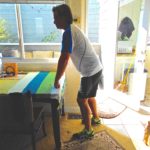The Patient that is Used To It
 One of the markers we use in Pulmonary Rehab is the Borg scale. We have patients rate their breathing from 0 to 10, and their exercise intensity from 0 to 10. It takes them a few weeks to get used to this, as most of them rate their breathing as either good or bad, and their exercise as either moving or….. not.
One of the markers we use in Pulmonary Rehab is the Borg scale. We have patients rate their breathing from 0 to 10, and their exercise intensity from 0 to 10. It takes them a few weeks to get used to this, as most of them rate their breathing as either good or bad, and their exercise as either moving or….. not.
But the most interesting patients to me are the ones that are sitting there, huffing and puffing, answering ….questions….. with…….one…….word…..answers…….. because…….. they are breathing so hard.
“How would you rate your breathing today?”, I ask, after giving them a minute to sit down and catch their breath.
“Zero”, they reply.
“Zero? No Shortness of breath at all?”
“Nope!”
Now, I don’t live in their body, but my best assessment would rate them at least a 4, if not a five.
What worries me is, what might prompt them to actually seek help should they become short of breath according to their own scale? When they reach ‘their’ 4 or 5? Pushing the ‘reset’ button on these folks takes a few weeks.
But for those patients in the hospital with COPD who never have gone to Rehab, RT and RN beware. Sometimes we get used to the scared patient who calls every hour for their prn treatment. Then, we finally make it in to see Mr. or Mrs. Q6, and whoa! A quick assessment before alerting the Rapid Response Team reveals a patient ready for a treatment alright, but perfectly calm. A gentle reminder that they can call for a prn treatment usually results in a wave-0ff.
This is where a COPD navigator would come in handy. A little bedside teaching on symptoms and a little review and optimization on the medications while in-hospital might just prevent a re-admission. Not to mention, the COPD navigator would likely recommend Pulmonary Rehab at discharge. If your hospital does not yet have a COPD care navigator, ask to make a position for one. They are valuable and needed !
